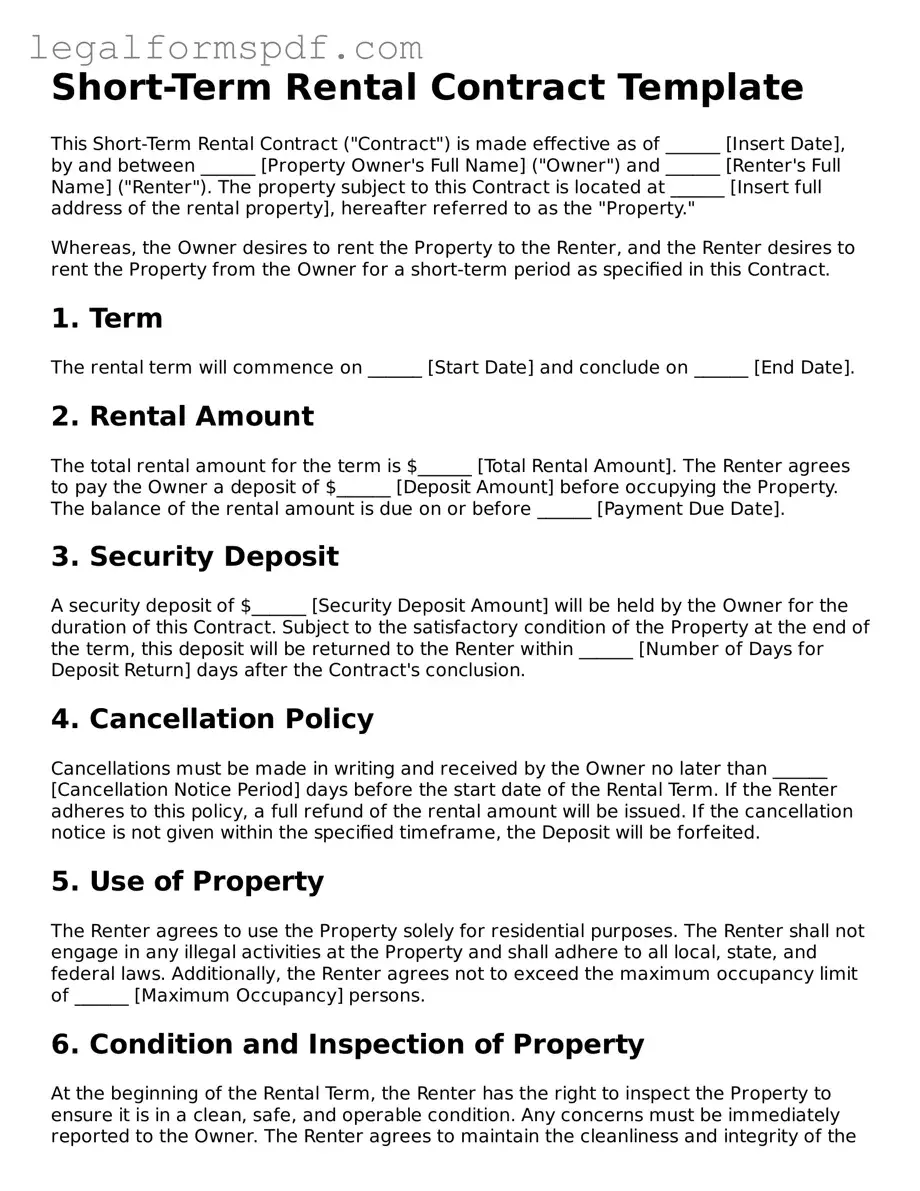Short-Term Rental Contract Template
This Short-Term Rental Contract ("Contract") is made effective as of ______ [Insert Date], by and between ______ [Property Owner's Full Name] ("Owner") and ______ [Renter's Full Name] ("Renter"). The property subject to this Contract is located at ______ [Insert full address of the rental property], hereafter referred to as the "Property."
Whereas, the Owner desires to rent the Property to the Renter, and the Renter desires to rent the Property from the Owner for a short-term period as specified in this Contract.
1. Term
The rental term will commence on ______ [Start Date] and conclude on ______ [End Date].
2. Rental Amount
The total rental amount for the term is $______ [Total Rental Amount]. The Renter agrees to pay the Owner a deposit of $______ [Deposit Amount] before occupying the Property. The balance of the rental amount is due on or before ______ [Payment Due Date].
3. Security Deposit
A security deposit of $______ [Security Deposit Amount] will be held by the Owner for the duration of this Contract. Subject to the satisfactory condition of the Property at the end of the term, this deposit will be returned to the Renter within ______ [Number of Days for Deposit Return] days after the Contract's conclusion.
4. Cancellation Policy
Cancellations must be made in writing and received by the Owner no later than ______ [Cancellation Notice Period] days before the start date of the Rental Term. If the Renter adheres to this policy, a full refund of the rental amount will be issued. If the cancellation notice is not given within the specified timeframe, the Deposit will be forfeited.
5. Use of Property
The Renter agrees to use the Property solely for residential purposes. The Renter shall not engage in any illegal activities at the Property and shall adhere to all local, state, and federal laws. Additionally, the Renter agrees not to exceed the maximum occupancy limit of ______ [Maximum Occupancy] persons.
6. Condition and Inspection of Property
At the beginning of the Rental Term, the Renter has the right to inspect the Property to ensure it is in a clean, safe, and operable condition. Any concerns must be immediately reported to the Owner. The Renter agrees to maintain the cleanliness and integrity of the Property during their stay and will return it in the same condition as at the start of the Rental Term, barring normal wear and tear.
7. Liability
The Owner will not be liable for any accidents, injuries, or loss of personal property that occurs during the Renter’s occupancy. The Renter agrees to hold the Owner harmless from any claims arising from any such incidents.
8. Governing Law
This Contract shall be governed by and construed in accordance with the laws of the State of ______ [Insert State]. Any disputes arising under or related to this Contract shall be subject to the exclusive jurisdiction and venue of the courts located in ______ [Insert County] County, ______ [Insert State].
9. Entire Agreement
This document and any attached addendums constitute the entire agreement between the Owner and the Renter. Any alterations or additions to this Contract are not valid unless agreed upon in writing by both parties.
Signatures
By signing below, both the Owner and the Renter agree to all the terms and conditions set forth in this Contract.
Owner's Signature: __________________________________ Date: ______
Renter's Signature: __________________________________ Date: ______
